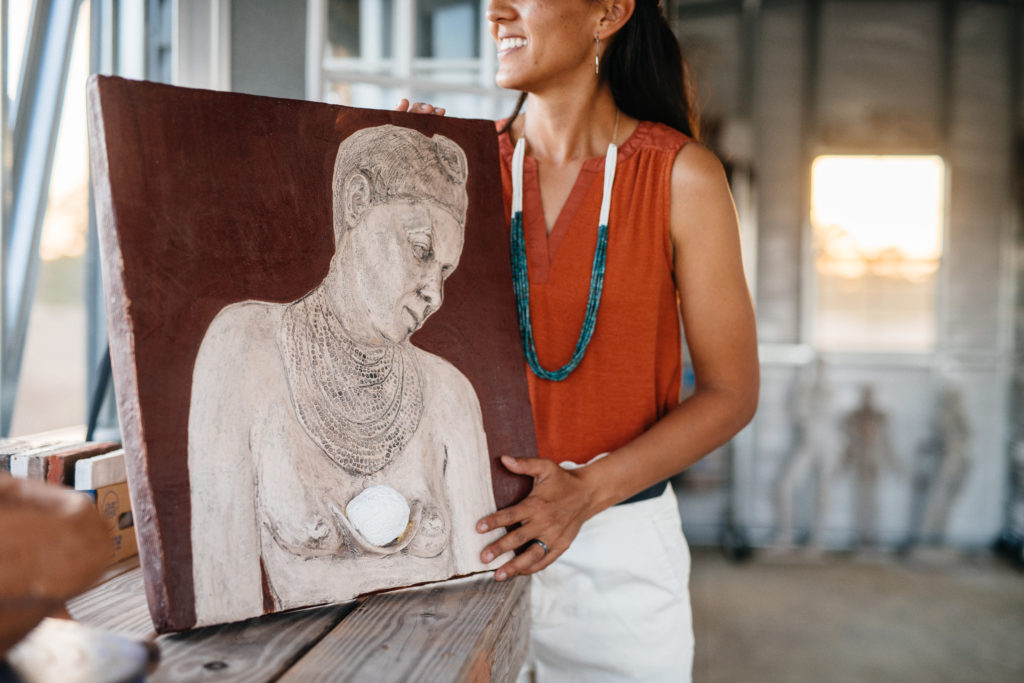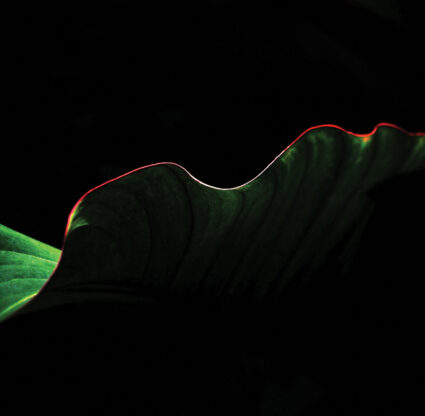Sunlight crawls over the thick grass at Campo de Velasco, rendering the blades into shards of glowing metal. Jessica Osceola —the Seminole artist who established this 10-acre farm with her husband, Benjamin Velasco, in 2018—has already been awake for a couple of hours, getting their two sons fed and ready for the day before she leaves to teach her ceramics class at Florida Gulf Coast University (FGCU).
“Everything I do is about cycles,” she says. “And the cycles keep on growing.” This is reflected in nearly every facet of her bustling life: the family she’s raising, the artwork she makes and teaches, the sustainable lifestyle she’s established. Though only in her late 30s, she’s already familiar with old Seminole traditions and their origins, identities, new adaptations and the wonder of life and—most profoundly—how to move forward after it ends.
Osceola, whose father is Seminole and whose mother is Irish-American, spent most of her childhood in her great-grandmother’s village along Tamiami Trail. Houses were small and modest, and most domestic activities took place under open-air chickees. She was first exposed to art in the village, where she remembers her father fashioning gifts from turtle shells and bent willow saplings. Her elderly female family members made a lasting impression, too, with their brightly patterned patchwork textiles fashioned into skirts, aprons and cloth dolls.
After graduating from FGCU in 2008, Osceola took a job at the Institute of American Indian Arts in Santa Fe, New Mexico, where she worked and lived among other Native American artists for a year. When she returned home, her sister Karie—the “much more still and patient” child who learned from her elders—started teaching Osceola Seminole patchwork. By 2010, Jessica Osceola began working full time as a traditional arts specialist for the Seminole Tribe, developing curriculums and teaching fellow tribe members how to sew, weave sweetgrass baskets and bead. She went back to grad school, completing most of her coursework from San Francisco’s Academy of Art University remotely, and in 2016, she graduated with a master’s degree in sculpture.
Though textiles play a prominent role in her artistic practice—Osceola’s 2021 solo show at the Marco Island Historical Society, aptly titled Creating Home, focused on her stitched works—the beating heart of her creative work is sculpture. As an artist, she braids the various strands of her education: the formal degrees; her more broad, structured study of Native American art; and the Seminole arts and crafts handed down through generations. She mostly creates ceramic self-portraits in the form of bas-reliefs—sculptures compacted onto a single shallow panel rather than a three-dimensional piece.
Bas-relief can be found in nearly every civilization as long as humans had tools to chisel stone. Sandstone carvings depict Hindu stories on the door lintels of Cambodia’s Angkor Wat temple, and scenes of deities were carved into the rock of Ancient Egyptian tombs. And though the Seminole—who trace their ancestry to the Southeastern United States’ earliest inhabitants nearly 12,000 years ago—aren’t known for creating bas-reliefs, Osceola’s sculptures add her tribe’s imagery to the artistic tradition.
Her process changed from freestanding, 3D sculptures once she delved into her thesis work, which revolved around photography, figures and sculptures. “Bas-reliefs fit the nook between sculpture and two-dimensional artwork,” she says. The pieces begin with Osceola photographing her own face and body. She translates those self-portraits into clay, using the mud to explore the “hard versus soft forms” of the human body and its emotions, her primary subject of interest.
The ceramics leave much of their clay exposed, its earthy hues and tactility perfect for depicting skin. “I always try to work with two colors, especially a redder-colored clay,” she says. “I know it’s stereotypical to talk about Native Americans as ‘red,’ but the Seminole do describe themselves as red-toned in their own language.” The faces possess startlingly frank expressions: They gaze out watchfully, more alert and self-possessed than distrusting. The bas-reliefs coincided with the birth of her first son in 2013. “So many of my self-portraits were about discovering and self-reflecting on motherhood,” she says. “I was thinking about how our child is the offspring of different situations—my dad’s Seminole heritage, my mom from Ohio, Ben being from Chile. No matter what, if you strip away the different exterior colors, it’s all the same clay underneath.”
Since Osceola’s artwork revolves around ideas of identity, multiculturalism and motherhood, it’s fitting that she uses clay—often associated with vessels and earth—as her medium. It makes sense, too, that she’s driven to cultivate the dirt on her farm. Osceola and Velasco, a personal trainer and retired firefighter, founded Campo de Velasco as a rustic reprieve, where bees buzz around wildflowers, tidy fences weave across the pastures and children can run and tumble on soft ground instead of over sprinkler heads.
The family had been living on 2.5 acres in Golden Gate Estates, but they dreamt of a more sustainable, rural lifestyle. Velasco grew up spending summers on cattle ranches in his native Chile and wanted cows of his own. Osceola didn’t blink at his wishes, having grown up watching her father hunt and fish. They also harbored concerns about their long-term environmental footprint and, most pressingly, the immediate effects of processed foods on their growing family’s health.
Their farm provides everything from protein to produce, and Osceola and Velasco complete each day’s hefty list of chores themselves. Besides tending an orchard with fruit trees, the couple grows low-maintenance produce (kale, turnips, tomatoes) that thrive naturally in Southwest Florida without chemical pesticides or fertilizer. Roaming chickens peck the ground on the range for insects, while gentler ducks provide pest control in the 60-by-60-foot garden. The family carefully breed miniature cows, called Zebu, that originated in Africa and India and adore the hot, humid weather. “Ben is their rancher, I’m their doctor, and our son Joaquin is my medical assistant,” she says.
The couple describes Campo de Velasco as a sustainable microfarm, meaning they only farm on a scale large enough to support their family of four. Their livestock grazes and eats hay while the poultry gets organic feed. And in lieu of chemical fertilizers, they make vigorous use of two separate composting systems and livestock-supplied manure to enrich their soil. The farm’s small size also helps conserve energy and water, with a pond on the property supplementing their small irrigation system. “It’s all interconnected,” Osceola says. “The animals eat clean food that they excrete onto the ground. Then their waste goes into the soil or even into the water runoff. That gets absorbed by the plants, which produce the veggies we eat. Then we compost from that produce, it goes back into the ground that the animals graze and it starts all over again.”
When the couple started Campo de Velasco four years ago, it wasn’t romanticized on a whim. They had their hands full: Jessica Osceola had just completed a graduate program with a toddler in tow and was teaching ceramics as an adjunct professor at FGCU, while Velasco worked long shifts as a firefighter and EMT in Immokalee.
The frequency of her art exhibitions—including an ambitious two-year traveling show of Native American artists from the Southeast, Return from Exile—took a backseat as she focused on building the farm.
During this time, her interest in sculpting also ebbed for personal reasons. In 2018, Jessica Osceola suffered an early-term stillbirth at just over 20 weeks into her second pregnancy. “We were so depressed,” she says. In a herculean effort to shield her then-4-year-old son, Joaquin, from the worst of their heartache, she’d hide in the shower to cry. “I wanted to wash away the feeling of death,” she says. “We had to ‘fake it ’til we made it,’ for Joaquin, you know? But he knew. I would tell him that I’m sad, that the sadness is normal, that it comes and goes.”
The clay’s tactility lost its appeal—the material and forms she made with it were too closely connected with motherhood. Anything resembling skin and flesh felt repugnant. “I just abandoned the material and work that was so connected to who I am,” she says. That’s when they decided to make good on their yearning for a proper farm, where they had room to heal. Using hard labor to distract themselves with a new focus, they cultivated a fresh start.
In 2020, Jessica Osceola found out that she was pregnant again. A couple of years had passed, but their grief was still sharp. “I was so scared all over again,” she confesses. “I had the fear of death constantly lurking over my shoulder.” Nine months later, in the spring of 2021, she gave birth to a little boy they named McCoy. Now a little over 1 year old with sandy hair, he’s healthy, strong and inquisitive. “I want other women to know there is life,” she says slowly and quietly, “after a stillbirth.”
For better or for worse, Jessica Osceola intimately understands life’s cycles. “The farm has taught me that nature has its own way,” she says. In the same way that she sustains Campo de Velasco so that her sons can feast from its land for years to come, she preserves her Native American traditions for her sons to pass on to future generations.
Joaquin, now 8, is busy learning Seminole arts from his mother, who continues to sew, bead, weave and carve. “If I stop, then it stops in my kids,” she says. “It is important that they see me practice and create in Seminole ways. My Seminole heritage is an undercurrent for so much of what I do and how I make decisions. That’s how I grew up. I want my sons to remember their roots.”





